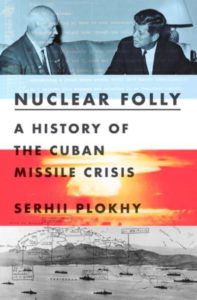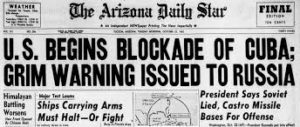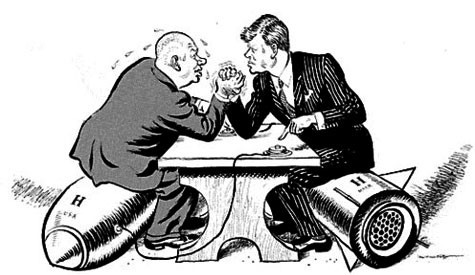Besides enjoying a galloping great read steeped in historiographical rigor and distilling nearly 60 years’ worth of memoirs, official and unofficial analysis, and declassified documents, readers of a certain age opening Serhii (Chernobyl) Plokhy’s exacting and propulsive Nuclear Folly may experience a weird tangle of recollection interspersing flashes of national unity rooted in existential dread and nostalgia for literate presidents. The prolific Ukraine-born historian, a professor at Harvard University, renders an oft-told tale in freshly revelatory, nail-biting terms as he recounts the 1962 exercise in international brinksmanship over emplacement by the USSR of tactical nuclear weapons around Cuba that laid a great swathe of the United States vulnerable to attack by missile and aircraft.

By Serhii Plokhy
Norton 2021; $35
Plokhy’s title is a nod to The March of Folly: From Troy to Vietnam, popular historian Barbara W. Tuchman’s 1984 cavalcade of ill-conceived conflicts. He also makes a quasi-character of The Guns of August, Tuchman’s Pulitzer Prize-winning 1962 account of the knuckleheadism that begat World War I. President John F. Kennedy, dance partner with Soviet Premier Nikita S. Khrushchev in the terrifyingly clumsy gavotte that Plokhy dissects, was an enthusiastic Tuchman reader who, well before the missiles of autumn were being installed, armed, and aimed, was assigning his generals and security advisers to read Guns. Amid the crisis itself JFK repeatedly invoked Tuchman’s theme: how misread cues and overlooked clues merged with paranoia and rampant nationalism to stampede Europe into what became a global war. However, that global war at least had involved only gunpowder and poison gas. In ’62, the great powers were messing about with nukes—building scads of them, testing them in the sky and under the ground, shaking them at one another like apes with cudgels.
Kennedy knew well the uses of threat, real and imagined. Among campaign tropes that had squeaked him into the White House in 1960 had been the “missile gap,” a rote assertion, later shown to be bogus, that the United States was lagging the Soviets at stockpiling rockets capable of carrying nuclear warheads. Khrushchev knew better; it was the USSR that was playing catch-up. But since the May 1960 downing of an American spy plane in Soviet airspace by ground-to-air missiles the Soviet premier had been on a roll, first bullying President Dwight D. Eisenhower over the U-2 affair, then roughhousing Kennedy, still tender from a recent debacle dating to the Eisenhower White House. Practically upon taking office the new president had had to eat a platter of crow baked by the grand failure of a vestigial CIA-plotted invasion of Cuba by exiles bent on ousting Khrushchev’s new best friend and fellow socialist, Fidel Castro. Castro’s 1959 overthrow of the dictator Fulgencio Batista and subsequent embrace of Soviet doctrine had qualified him as an ally and junior partner—or so Khrushchev thought—in the cause of international revolution, teeing up the tale Plokhy tells so well.
At a summit meeting that June in Vienna, Austria, the bumptious Khrushchev, 23 years Kennedy’s senior, ignored set topics. He hammered the younger man, demanding the western allies quit West Berlin and leave that city to the Sovs. Kennedy, still smarting from the Bay of Pigs, took it hard. Two months later up went the Berlin Wall, a fresh thumb in Kennedy’s eye that embodied the Cold War, as did another Eisenhower-era legacy: American missiles installed at bases in Turkey and aimed at the USSR. Plus, the Yanquis were getting on socialist newbie Fidel’s last nerves by keeping their base at Guantanamo Bay per a 1903 contract and constantly sending camera-equipped warplanes over Cuba. The Soviet premier wondered if Russian missiles 90 miles off Florida wouldn’t make a fine chip to play in the Great Game. Tit-for-tatting the Americans could muscle those missiles out of Turkey and bind Castro more tightly to the USSR and away from Red China, Khrushchev speculated.

So Nikita went all in and ships packed with warheads, bombs, and missiles—surface-to-air and ballistic—along with thousands of Red Army troops to install and staff those rigs made for Cuban ports, briefly in secret and then with worldwide notoriety. Media coverage brought a star turn at the United Nations for U.S. Ambassador Adlai Stevenson. Much huffery and puffery from both sides ensued, along with a confrontational naval quarantine and a humiliating Soviet withdrawal, but not before the Americans had inched up on invading Cuba and Castro, irate at his JV status, had ordered his pet Russians to blow a U-2 out of the air, edging all parties too close to obliteration for comfort and leading to a collective wheeze of relief and pioneering nuclear disarmament treaties. Whether revisiting grave memories or encountering this breath-taking story for the first time, a reader will find in Nuclear Folly a balanced, nuanced, and insightful consideration of one of recent history’s scariest passages. —Several times during the Cuban missile crisis, American History editor Michael Dolan and classmates took shelter in the auditorium at Holy Redeemer School in Berwyn, Maryland, roughly 8.5 miles northeast of what would be Ground Zero in Washington, DC.
This story contains affiliate links. If you buy through this page, we might get a commission. Thanks!





